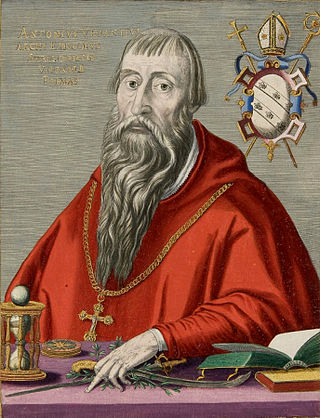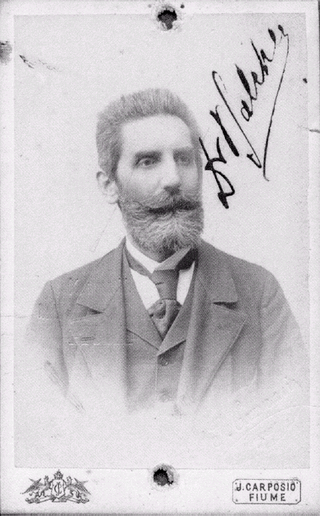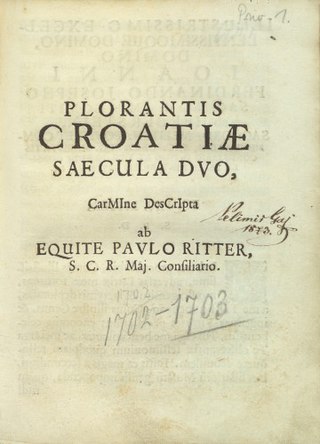
Fausto Veranzio was a Croatian polymath and bishop from Šibenik, then part of the Republic of Venice.

Anthony Francis Lucas was a Croatian-born American oil explorer. With Pattillo Higgins, he organized the drilling of an oil well near Beaumont, Texas, that became known as Spindletop. This led to the widespread exploitation of oil and the start of the Petroleum Age.

The Croatian Navy is a branch of the Croatian Armed Forces. It was formed in 1991 from what Croatian forces managed to capture from the Yugoslav Navy during the breakup of Yugoslavia and Croatian War of Independence. In addition to mobile coastal missile launchers, today it operates 30 vessels, divided into the Navy Flotilla for traditional naval duties, and the Croatian Coast Guard. Five missile boats form the Croatian fleet's main offensive capability.

Večernji list is a Croatian daily newspaper published in Zagreb.

Petar Preradović was a Croatian poet, writer, and military general. He was one of the most important Croatian poets of the 19th century Illyrian movement and the main representative of romanticism in Croatia.

The Meštrović Pavilion, also known as the Home of Croatian Artists and colloquially as the Mosque, is a cultural venue and the official seat of the Croatian Society of Fine Artists (HDLU) located on the Square of the Victims of Fascism in central Zagreb, Croatia. Designed by Ivan Meštrović and built in 1938, it has served several functions in its lifetime. An art gallery before World War II, it was converted into a mosque under the Independent State of Croatia and was subsequently transformed into the Museum of the Revolution in post-war Yugoslavia. In 1990, it was given back to the Croatian Association of Artists. After extensive renovation, it has served as a space for exhibitions and events since 2006.

The Croatian Coast Guard is a division of the Croatian Navy responsible for protecting the interests of the Republic of Croatia at sea. The Croatian Navy is composed of classical naval forces structured into a flotilla and the Coast Guard that solely consists of ships with peacetime duties, e.g. protection of ecology, fishing, control of tankers, ballast waters, combat against terrorism, trafficking of people, narcotics, and similar.
Croatian literature refers to literary works attributed to the medieval and modern culture of the Croats, Croatia, and Croatian. Besides the modern language whose shape and orthography was standardized in the late 19th century, it also covers the oldest works produced within the modern borders of Croatia, written in Church Slavonic and Medieval Latin, as well as vernacular works written in Čakavian and Kajkavian dialects.

Antun Vrančić or Antonio Veranzio was a Croatian prelate, writer, diplomat and Archbishop of Esztergom in the 16th century. Antun Vrančić was from the Dalmatian town of Šibenik, then part of the Republic of Venice. Vrančić is also known under his Latinized name Antonius Verantius, while Hungarian documents since the 19th century refer to him as Verancsics Antal.
Jakov Sedlar is a Croatian film director and producer. A former cultural attaché during the 1990s in the Franjo Tuđman government, his documentaries promote Croatian nationalist views through propaganda. His 2016 documentary Jasenovac – The Truth sparked controversy and condemnation for downplaying and denying the crimes committed at the Jasenovac concentration camp by the Ustaše during World War II, instead focusing on crimes supposedly committed against Croats by communist Partisans at the camp following the war, while using alleged misinformation and forgeries to present its case, in addition to naming former and current Croatian officials, intellectuals, historians and journalists it dubs as "Yugoslav nationalists concealing the truth".

Mihovil Pavlinović was a Croatian Roman Catholic priest, politician, and writer who led Croatian National Revival in the Kingdom of Dalmatia. He is known as a keen promoter of Croatian political thought in Dalmatia, one of the founders of the liberal People's Party and consistent advocate of unification of Kingdom of Dalmatia and Kingdom of Croatia-Slavonia.

Fragmenta Vindobonensia, also known as the Vienna folios, is the name of two illuminated Glagolitic folios that most likely originate from 11th or 12th-century Croatia and Dalmatia.

Peter Salcher was an Austrian and Croatian physicist.

The Croatian Partisans, officially the National Liberation Movement in Croatia, were part of the anti-fascist National Liberational Movement in the Axis-occupied Yugoslavia which was the most effective anti-Nazi resistance movement led by Yugoslav revolutionary communists during the Second World War. NOP was under the leadership of the League of Communists of Yugoslavia (KPJ) and supported by many others, with Croatian Peasant Party members contributing to it significantly. NOP units were able to temporarily or permanently liberate large parts of Croatia from occupying forces. Based on the NOP, the Federal Republic of Croatia, which was referred to by Winston Churchill as "the Croatian miracle" was founded as a constituent of the Democratic Federal Yugoslavia.

Plorantis Croatiae saecula duo is a poetical work by Pavao Ritter Vitezović, published in 1703 in Zagreb. As with many of Vitezović's works, it is written in Latin. The unusual structure of the work makes it difficult to classify, being variously described as a poeticized chronicle, historical epic, pseudo-autobiography, or allegory. Containing nearly 2000 lines of verse, the poem recounts the previous two hundred years of Ottoman Wars being narrated in first person by a personified Croatia, who is presented as an allegory to the Catholic topos of the weeping mother. These events, including wars, plagues, famines, are given as a history of personal suffering to the personification, containing detailed psychosomatic elements. It is dedicated to the Austrian field marshal Johann Ferdinand Josef Herberstein.
Vlaho Stulli, was a Croatian and Ragusan poet, playwright and public servant of the Republic of Ragusa. Influenced by Croatian-Ragusan writers Nikola Nalješković and Marin Držić, as well as Italian Carlo Goldoni, he is best known for his naturalistic satire comediographic work Kate Sukurica in Croatian, Diario (Diary) in Italian and epigrams in Latin language, written to his friends. Stulli lived and wrote during the period of the stronger influence of the French language and literature in Dubrovnik, whose writers and playwrights translated many of Molière's comedies into Croatian, adapting them to local idiom and mentality, as well as influences of Latin language, Italian language theatre troupes and style-pluralistic Croatian literature; the 18th century being considered the "golden century" of Ragusan literature. Stulli is the most prominent representative of the late 18th-century Ragusan drama and his comedy Kate Kapularica the best Ragusan play of that time.

















